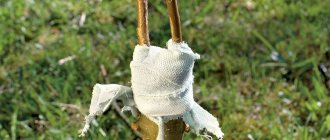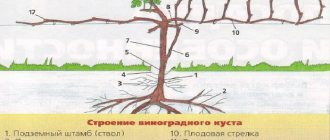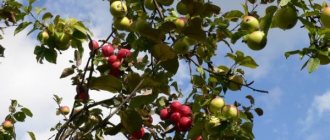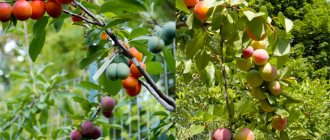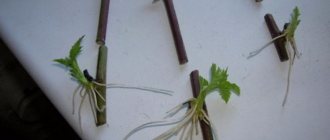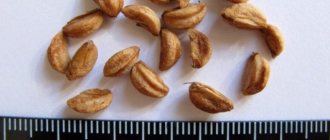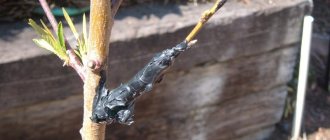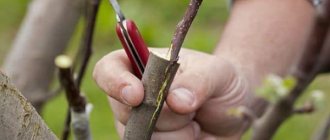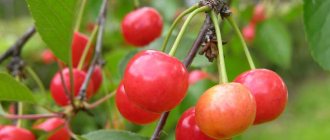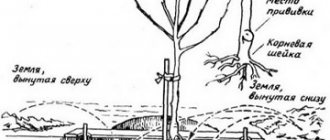It is, of course, impossible to grow all varieties of apple trees in one garden, but through grafting you can significantly expand the range of available varieties.
There are different opinions about grafting - some say that this procedure is difficult to perform, and it would be much wiser to purchase a new seedling, others say that everything is extremely simple - they took a cutting and grafted it onto a tree in 30-40 minutes.
If everything goes well, then after a couple of years it will be possible to harvest a harvest of delicious crossed apples. When the grafting doesn’t work out as expected, there will be no apples, and the costs are a pity. We do not recommend that you refuse vaccination, but it definitely won’t hurt to approach the matter wisely in order to minimize the risks of rejection.
Why not propagate cultivated apple trees by sowing seeds?
It would seem that sowing seeds is the easiest way to propagate apple trees. Sow and wait until it sprouts and bears fruit. But the wait in this case will last a very long time: apple trees produce their first harvest after about the 5th year of growth, and only if the tree has been replanted at least three times before.
If the apple tree has not been replanted during its entire growth period, wait for the first harvest in the 15th year of growth.
Based on this, another question arises: what is special here? I replanted the apple tree three times and that’s it, wait for the first apples in the fifth year. But even here it’s not so simple. Any seed fruit crops do not inherit parental characteristics. This statement also applies to apple trees. So, when you grow a crop this way, you always leave a huge amount of intrigue because you don’t know what you’ll get in the end. You can spend a lot of time growing, but end up with completely inedible fruit, although very attractive in appearance.
Although there are exceptions to any rule. In this case, the exception is a group of old, but quite edible folk apple varieties. They are now planted much less frequently than new breeding varieties, but this does not make them any worse. The advantages of such varieties are durability and excellent adaptability to any growing conditions, but the disadvantages are the large height of the trees (difficult to care for) and the late date of fruiting.
So, to make the work easier, experienced gardeners advise the shortest way to an apple harvest - grafting onto wild animals.
Deadlines
In theory, vaccination can be carried out year-round, but the most suitable and effective time for this is spring - from early March to early June, depending on the climate zone. In spring, sap flow begins. During this period, air temperature and humidity data are at a favorable level, facilitating trouble-free survival.
For productive spring grafting, it is better to start work as soon as the snow cover melts. In the middle climate zone, this usually occurs at the end of March - beginning of April.
Cuttings without swollen and enlarged buds are used as a scion. If you miss this moment in the spring, then vaccination will have to be postponed until the summer. In view of this, you should choose the timing and timing of apple tree grafting in the spring so that there is no risk with the scion, focusing on the following factors:
- position of the kidneys during sleep. It is necessary to meet the deadline before the process of sap flow and swelling of the kidneys begins;
- state of the moon. It is recommended to carry out the plant grafting procedure during the waxing moon;
- the presence of warm and cloudy weather, preferably without wind and rain. Better in the morning or evening.
Experienced gardeners advise grafting fruit trees closer to the full moon, when the Moon is in Aries, Taurus or Leo. During the period of the waxing Moon, the forces and juices of the plant are more quickly directed to the new shoot, helping its speedy engraftment.
When is the most effective time to vaccinate wild animals?
The procedure requires a strong and good wild game, which will absorb all the nutritional compounds from the ground through its root system:
- Spring grafting is done when the buds have not yet begun to bloom, but the frosts have definitely passed and will not return. This time usually falls in March. The second time the procedure is carried out when the active movement of juices begins on the rootstock (this is approximately April - May). This time is considered the most successful, since the vaccinations take root and adapt well.
- If for some reason the grafted tree does not take root in the spring, then another grafting can be done in the summer. For this purpose, the graft must be prepared either in late autumn or early spring (by the time of grafting it will still be dormant). The procedure is carried out from the middle to the end of the summer season (late July - late August), when the trees begin the second period of active movement of sap. For the scion, you need to take the branches and buds that have developed in the current season.
- In the fall, grafting should be carried out so that the apple tree still has time for normal preparation for wintering. So, the best time to carry out the procedure will be the beginning of September, since further the movement of juices will begin to slow down and will end with the falling of leaves and, accordingly, hibernation. And the scion must have time to adapt to new conditions during this time, or it will die.
For autumn grafting, you need to cut off a cutting from a shoot, the length of which will reach 40 cm and the age of one year.
Why graft an apple tree with fresh branches in summer?
Grafting trees in spring, methods of grafting fruit trees for beginners
Most gardening experts prefer to graft apple trees with fresh green branches in the summer. It is noted that this procedure has many advantages:
- with summer grafting, the cuttings take root and begin to bear fruit a season earlier than with autumn grafting;
- there is no need to prepare grafting material in advance. You can graft freshly cut branches, while for spring grafting cuttings must be prepared in the fall;
- fresh cuttings are always high-quality material. In the case of summer vaccination, they are used in full. Branches harvested in the fall may deteriorate during wintering.
How to grow a wild apple tree for grafting
If you already have a wild fruit tree somewhere on your property, then you can safely use it. However, if you do not have such a resource, you will have to grow it yourself.
Growing wild game from seeds yourself
For this growing method, you will need seeds of frost-resistant apple trees that grow specifically in your area (this is important!).
- You need to collect seeds in the fall; choose the largest fruits to collect seed.
- Rinse the seed and dry it.
- During the period from January 15 to 25, it is necessary to stratify the seeds. Cover them with sand and put them in the refrigerator.
- You can also sow seeds in the garden at a depth of 30–40 mm in autumn. Then they will be covered with snow all winter, and in the spring they will sprout. By autumn you will receive healthy and strong seedlings.
Scion storage
The scion is tied into bundles and labeled if it was collected from different varieties of apple trees. The amount of material is always prepared with a reserve, in case some of it disappears during storage. Cuttings can be stored outside in the ground. To do this, dig a trench about 30 cm deep in the ground. Spruce branches are laid at the bottom, scion is folded, covered with spruce paws, covered with earth or dry sawdust. After snow falls, they additionally cover the soil.
Another option for outdoor storage is in sawdust. A layer of dry sawdust is poured onto the soil, the cuttings are stacked, and a layer of wet sawdust is covered on top. After the first frost, the top layer will freeze, after which it is covered with another layer of dry sawdust 25-30 cm thick. The top is additionally covered with a plastic bag. The easiest way to preserve the scion is to put it in the refrigerator. To do this, wrap it in a wet cloth, put it in a plastic bag, and place it on the middle shelf, but not in the freezer.
The grafting material can be stored in the cellar in pots or boxes. The containers are covered with a plastic bag with holes and half filled with dry sawdust or sand. Insert the cuttings with the cuts down and sprinkle with wet sawdust or sand. To prevent them from becoming moldy, it is necessary to maintain temperature and humidity conditions. Temperature from 0° to +1°С, humidity from 60 to 70%.
Important!
In winter, mice can grow in the sawdust and ruin the scion, so it is better to moisten the sawdust not with water, but with carbolic acid, the smell of which repels rodents.
The nuances of the procedure in different seasons
You need to prepare the scion in the fall, cutting off the branches after the first frost, and also cutting them into segments. In such cuttings, sap flow is slow, so they practically do not experience stress from pruning.
For the scion, choose branches 20–30 cm long with at least 5–6 buds. Such cuttings should be stored indoors at a temperature of 0 degrees, placing them in damp sand. The sand needs to be moistened periodically as it dries.
Spring grafting
This time is considered the most effective for grafting: 1. The “split” grafting procedure is carried out before the active movement of juices in the tissues of the tree begins.
2. The “bark” grafting method, as well as budding with a germinating eye, improved copulation and “butt” are best suited for grafting when the juices begin to flow.
Summer grafting
In the summer, the second period of active sap flow begins, so it is possible to graft a cultivated variety onto a wild apple tree “by the bark”, “into the cleft”, by budding with a sleeping eye, by improved copulation and “in the butt”. In the middle zone of the country, it is best to carry out budding in mid-summer (around the end of July), and for the southern regions, mid-late August is suitable.
Autumn procedure
In autumn, the effectiveness of grafting is not as high as in spring or summer.
However, if the warm weather in the region is delayed, then you can try budding in early to mid-September). You can also use the “butt” method or perform an improved copulation (not for beginners). It is advisable to complete the grafting with budding approximately 14–21 days before the onset of stable +15 outside. Adult plants are not grafted at this time. In the southern regions, vaccination is also possible in October.
Vaccination methods
The variety of methods can be divided into two categories:
- kidney;
- cuttings
They have their own characteristics that need to be taken into account in their work.
Kidney grafting
In another way, it is also called budding (from the Latin oculos - eye) or eye grafting. This is the most common method for apple trees. It allows you to obtain many seedlings from one mother tree with minimal financial and physical costs. The procedure is usually carried out in mid-summer, when the tops of the new shoots of the apple tree become woody and cease to be soft.
Preparation of cuttings and tools
First you need to decide on the rootstocks. You can dig up apple tree shoots, sow seeds, or plant clonal plants. The latter should be at the site where the grafting is planned until the buds open. It is best to plant them in the fall, since the roots of the apple tree grow even under snow if the ground temperature is positive. During the summer, the rootstocks are regularly weeded, fed and watered. By mid-July, they must be as thick as a pencil - this will greatly facilitate the process of the eye’s take root.
The tools are also purchased and prepared in advance. The most necessary thing is a budding knife. You should not replace it with a kitchen or office one yourself. This can only be done by an experienced ophthalmologist who knows all the features of the process. An old Soviet-style budding knife is cheap and is sold in almost any store. However, then it will have to be sharpened for a long time at an angle of 30° to the block, first on a rule with coarse grain, then with medium and fine grain. Finish sharpening on a special leather belt. During operation, after 3–4 cuts, the knife is treated with GOI paste.
The Soviet-style budding knife is the cheapest, but also the most labor-intensive, requiring a long and careful sharpening
Now there are branded knives that do not need to be sharpened, just periodically adjust the cutting edge on a special diamond-coated whetstone. They are several times more expensive, but much more convenient to use.
In addition to the knife, you will need budding film. Here gardeners adapt as best they can. The grafting site is wrapped with electrical tape (sticky side up), T-shirt bags are cut into strips 1.5–2 cm wide, and cling film is used. You can try several options and decide which one is right for you. There is a special budding film - breathable or self-degrading. Unfortunately, the first one is rarely on sale, even on the Internet, and the second “works” only in the southern regions, where there is a lot of sun and long summers.
Timing for eye vaccination
Budding is carried out around the end of July - beginning of August. Depending on the region and weather, the dates may shift in one direction or another by an average of a week. To determine the readiness of the scion for surgery, take a one-year-old shoot of an apple tree and cut off a bud with a shield from it, as for grafting. If the knife moves smoothly and easily grabs part of the wood, the cuttings are ripe. Is the bark slipping off the eye and the wood is soft and watery? We still need to wait.
Three to four days before grafting, they begin to prepare the rootstocks. Plants are weeded and watered at least once a day, and in hot weather - twice, in the morning and in the evening. This enhances sap flow in the plant. During budding, the bark will be better separated from the wood, and the eyes will take root well.
In the evening before budding, the rootstocks must be washed almost from the very ground to a height of 15–20 cm. The site of future grafting should be approximately in the middle of the clean area. The plants are first wiped well with a wet rag, and then with a dry one, so that dust does not stick to the wet surface. This operation will allow you to avoid mold and rotting of the budding in the future.
Next, we decide where we can get cuttings for the scion. If a tree of the desired variety grows next to the site, it’s very good. You can take fresh cuttings immediately before surgery. If not, you will have to go to a specialized nursery or ask friends. Under no circumstances should the cuttings be completely immersed in water during storage; this will wash out the nutrients. For budding, it is advisable to choose strong vertical shoots from the upper or middle part of the crown. Horizontal weak branches and “tops” - strongly growing fatty shoots - are not suitable. Cutting is done early in the morning, while it is still cool. The leaves are removed carefully so as not to damage the buds - they are pulled up or cut off, leaving part of the petiole on the shoot. If transportation is intended, wrap it in a wet rag, then in film (cut shoots are stored for no more than 5 days). If budding will be carried out on the same day, place it in a container with water in the shade and cover the top with a wet rag (need to be moistened periodically).
To budding an apple tree, choose strong shoots: they need to be cut at the top and bottom to the desired length, cleared of leaves
Budding process
The budding itself is best done at dawn or two hours before sunset in good clear weather. The operation is not performed in the rain or on a hot afternoon. An apple tree is usually grafted with a “butt” shield or with a tongue.
Procedure:
- We place the budding knife on the bark of the rootstock at the site of the intended grafting.
- We make sure that the cut bark is smooth and uniform.
- We plunge the knife into the tree and move it down in a very gentle arc.
The result should be a small hole literally 2–3 mm deep and about 2 cm long. The wood must also be cut off, not just the bark. When budding with a tongue, the wood is not completely cut off, but remains attached at the bottom. A kind of pocket for the kidney (tongue) is formed. The hand is constantly tense when working and controls all movements of the knife. The sliding of the blade should be smooth, uniform and without jerking.
Budding with a tongue better fixes the bud on the cut; it is supported by a “pocket” of bark
Only after an incision is made on the rootstock is the shield with the bud removed from the scion cuttings. Everything needs to be done as quickly as possible so that the cuts on both parts do not have time to dry. Therefore, it is better to place the container with cuttings nearby while working. Also, do not touch the cut itself with your hands. When transferring the shield, you need to press it with your finger against the blade or hold it by the petiole. Be sure to ensure the exact alignment of the bark sections of the scion and rootstock.
After combining the cambium (green part), the graft is tied with film. It’s better to start from the bottom, so it’s easier to notice errors and displacements. The edge of the tape is pressed a centimeter below the kidney and securely wrapped with several turns. Then, maintaining tension, they move upward in a spiral. The film should overlap, so that there are no areas of open bark left. The kidney is not wrapped, it remains visible. The winding is continued 1–1.5 cm above the graft, then the tip is cut off and secured, inserting it under the last turn.
Butt budding is performed if the gardener missed the required time and the bark for the rootstock no longer comes off. Another reason for this method: the rootstock is too thick or thin, which is not used in other types of grafting.
The “butt-butt” budding method is considered one of the simplest - you need no more than half an hour for the entire process, from preparing the area on the scion to fixing the shield
Aftercare
It takes approximately 1.5–2 months for the grafted elements to grow together. In the fall, the wrapping is removed, and part of the rootstock above the graft is cut off. In this form, the new apple tree goes to winter. During the winter, those buds that have taken root poorly may die, so seedlings should always be made with a reserve. Over the next two years, the plants are periodically watered, fed, weeds are removed as necessary, the soil is loosened or mulched. Two-year-old seedlings are transplanted to a permanent place and form a crown as desired.
Video: budding of fruit plants
Grafting with cuttings
In this category there are:
- spring copulation;
- winter vaccination;
- grafting into a cleft or bark into the crown of an adult tree.
Grafting with cuttings is done only in winter or early spring. In summer, cut shoots dry out quickly, and in autumn there is not enough sap flow for the grafting parts to grow together.
Spring copulation
Grafting with cuttings is carried out very early, most often in March, when sap flow has just begun and the leaves have not yet blossomed. There may even be snow at this time. The timing is determined by the birch tree - if birch sap is already collected, then it’s time to start grafting.
Stages of copying:
- Preparation of rootstocks. They are planted in advance, in the fall or spring of last year. The thickness of the trunk near the ground (at the grafting site) should be approximately the size of a pencil. You can individually graft the skeletal branches of a young apple tree (3–5 years old). They should also be as thick as a pencil near the barrel.
- Cutting cuttings. The shoots are harvested after leaf fall, when frost sets in. You cannot cut the material during thaws. For spring copulation, annual unbranched shoots are used. Until the time of grafting, they are stored in a damp cloth in the cellar or vegetable compartment of the refrigerator (at above-zero temperatures), periodically inspected and, if necessary, washed from mold with a cool, pale pink solution of manganese. If there are a lot of cuttings, they can be stored in a snow pile. To prevent the snow from melting, the top is covered with straw. If a tree of the desired variety grows nearby, cuttings are cut immediately before grafting.
- Tools. You will need a well-sharpened budding knife and film for winding (as for budding). Additionally, you need garden pitch or MA-15 “iron lead” paint to cover the top cut of the cutting. If you leave the cut open, the top of the graft will dry out quickly without access to the roots.
- Copulation process: The cuttings are taken out of storage and carefully examined. Branches without damage, mold or signs of rot, with living buds, are suitable for grafting.
- The cuttings are wrapped in a damp rag and taken to the work site.
- The grafting site is determined. Usually this is a stem at a height of 10–15 cm from the ground or skeletal branches at a distance of 4–5 cm from the central conductor.
- At the copulation site, a long oblique oval cut (2–3 cm) is made. In the middle there is a cut 1.5 cm deep.
- Then a cutting of the same thickness as the rootstock at the grafting site is selected. At the bottom, they also make an oblique long oval cut and cut it in the middle 1.5 cm deep. 3-4 buds are counted from the bottom cut and the top is cut off (literally 2-3 mm above the bud).
- Oblique cuts of the rootstock and scion are inserted into each other. It is important to align the bark on at least one side and bottom.
- Then they wrap it with tape. They start 1.5 cm below the grafting site and gradually move upward in a spiral, 1.5 cm above. The turns of the winding overlap each other slightly so that there are no areas of exposed bark. The top cut is covered with garden pitch or red lead - a very thin layer and only on the cut itself. If you use a lot of pitch, then when it gets hot, it will flow and damage the bark due to lack of oxygen.
Garden varnish is an ambulance for fruit plants, quickly heals injuries, promotes bark restoration
Video: improved copulation with a tongue for fruit plants
According to the Lunar calendar, spring grafting of fruit trees is successful on the eve of the full moon (on the 11th–13th lunar day), if the Moon passes under the signs of Cancer, Scorpio, Capricorn, Aries and Leo.
Winter procedures
Winter grafting allows you to work indoors while sitting comfortably at your desk. In addition, at this time there is practically no business on the site. It is similar to spring copulation, but has a number of features. The main problem is maintaining temperature and humidity conditions, for which you will have to allocate a separate room and equipment.
- Preparation of rootstocks. For winter grafting, the rootstocks are dug up and stored in a cool, dark room. Digging is done immediately after leaf fall, when the plants have already fallen asleep and the soil is not yet frozen. The roots are thoroughly washed and soaked for two hours in a root rot disinfectant (Maxim, Benazol). Then they are covered with wet sawdust or grass cuttings, and periodically watered with a disinfectant.
- Winter grafting process. Cuttings are cut in the same way and at the same time as for spring copulation. A similar tool is needed. 3-4 weeks before planting the plants in the ground, the rootstocks are taken out of storage and kept in a warm room for about a day so that the process of sap flow begins.
- Then the scion cuttings are taken out and copulation is done in the same way as with spring grafting.
- The top cut of the scion cutting can be covered with garden varnish or completely dipped in special wax. It covers the plant with a thin layer and prevents it from drying out. In addition, for winter grafting there is a table pruner. He makes the same horseshoe cut on both parts of the graft. The survival rate in this case depends on the sharpness of the blade and on the thoroughness of combining the bark of the scion and rootstock.
Video: features of winter grafting using stone fruits as an example
Instructions for grafting into clefts
This operation is also carried out early in the spring. It is usually done when the thickness of the rootstock is much greater than the scion cuttings. Cleft grafting is done into the stump of a cut tree or into the stump of a skeletal branch when replacing an old unproductive variety.
- Preparation of cuttings - in the same time frame as for spring copulation.
- Treatment of the rootstock - immediately before grafting. For this method, smooth, rounded cuts are made.
- The grafting process: First, the cut branch or stump is carefully split in the middle, and a screwdriver or other improvised tool is inserted into the split, which can be easily pulled out.
- The scion cuttings are cut at the bottom on both sides so that a long (4–5 cm) flat wedge is obtained. The cut is round at the top, leaving 3-4 living scion buds.
- The resulting pegs are inserted into the split on both sides, and the screwdriver is carefully pulled out. It is important that the cuttings enter the split to the end; the beginning of the lower cut should not be visible from above.
- The grafting site is wrapped with film, the damage is covered with a thin layer of garden varnish or paint.
Stages of grafting into clefts: preparation of pointed cuttings, chopping on the rootstock, fixation and treatment with garden varnish
When grafting into a split, arched supports are used to protect thin shoots from being broken by birds and strong winds.
Video: split technique, progress
How to graft behind the bark
Grafting behind the bark allows you to form a new skeletal branch with a one-sided crown. It is carried out at the same time as cleft grafting and spring copulation.
- Preparation of cuttings is similar to spring copulation.
- Preliminary work with the rootstock is not required.
- Grafting process: At a selected location on the tree, a vertical cut is made down to the wood.
- Using a knife or screwdriver, the bark is carefully separated on the sides of the cut and at the bottom to form a pocket.
- The scion cutting is sharpened flat and inserted under the bark. The upper cut is round, even, above the bud. The cuttings should have 2-3 full-fledged living buds.
- The grafting site is fixed with tape, open areas of wood are coated with garden varnish.
Further care is the same as for an ordinary tree. During the season the winding is loosened several times. The strongest shoot is left from the sprouted buds, which is carefully bent or cut at the desired angle next year.
Grafting an apple tree with a cutting behind the bark takes root quite quickly and forms a new skeletal branch of the tree.
Video: performing the “bark” method
https://youtube.com/watch?v=wZjqsgHZzFE
Special case: bridge grafting
If over the winter hares and mice have gnawed the bark in a ring around the trunk (skeletal branch), this can lead to the death of the plant. Experienced gardeners recommend bridge grafting. To do this, before the buds swell, it is necessary to prepare cuttings 10–13 cm in length exceeding the height of the damage on the tree. For a young apple tree with a trunk diameter of up to 3 cm, two or three cuttings are enough, for an adult one you will need seven to eight or more. The “bare” ring needs to be cleaned and leveled. Oblique cuts (2–3 cm) are made on the cuttings from above and below, then the lower edge is aligned with the lower cut of the rootstock, and the upper edge with the upper one. As a result, you should have a bridge connecting the edges of the ring. Repeat the procedure with all the cuttings, secure them with film or strapping, and treat the damaged areas with garden varnish.
What is needed for the grafting process
To complete the procedure, you will need a whole set of tools that any self-respecting gardener should have:
- a knife with a short but sharply sharpened blade;
- grafting knife;
- budding knife;
- pruning shears (or hacksaw for wood).
It is also advisable to purchase a special grafting pruner. Models of grafting pruners may have different configurations, number of blades and cutting method. Advantages of the grafting pruner:
- much lower level of injury compared to conventional tools;
- allows you to make shaped cuts so that the coincidence of the cut parts is absolute;
- allows you to make the most accurate and thin sections for budding.
Possible reasons for damage to cuttings
Most often, the material deteriorates if the temperature and humidity conditions are not observed when stored in the cellar. High humidity leads to mold growth. If several moldy spots appear on the cuttings, they need to be carefully wiped to remove mold and condensation from the surface. The main thing is not to damage the kidneys. Afterwards, the material is immersed for several minutes in a solution of copper sulfate or 1% iodine solution. After drying, return to storage location. If the cuttings are almost completely covered with black mold, they are thrown away; they are unsuitable for grafting.
The scion may freeze if it is covered with a thin layer of sawdust or snow outside. To check whether the cuttings have frozen, the sections on them are renewed and placed in water. If it has darkened, the material has frozen; if the color has not changed, the temperature conditions correspond to storage. Frozen branches have a watery, glossy appearance. The scion can germinate if it is stored at a high temperature - above 6°C. This scion is not suitable for fusion. Also, at high temperatures it can dry out.
What care do grafted trees need?
The graft wrapped in elastic material should be inspected and checked every 14 days. You can also, if necessary, loosen the strapping somewhat so that it does not grow into the tree bark. It is necessary to protect the operation site from birds and pinch shoots throughout the summer.
For an apple tree that was grafted in the spring or summer, the bandage is removed after 60 days, but for a wild apple tree that was grafted in the fall, the bandage is removed in the spring, when all the snow has melted.
When the graft adapts, the buds will wake up and shoots will begin to form from them. There is no need to leave them all, choose only the strongest one (usually the top one).
At the end of July - beginning of August, remove the tips of the shoots on the cuttings. This will help stop the intensive growth of the cuttings in length and stimulate growth in width. In addition, this technique will help speed up the fusion of the scion and rootstock. Those shoots that grow below the graft need to be cut off (they only take away nutrients from the cutting).
It is also necessary to tie the regrown shoots to the support:
- this should be done for the first time when they grow by 20–25 cm;
- the second time the procedure is carried out when they reach a length of 40–50 cm.
A grafted wild bird needs regular watering and feeding in the summer.
Variety and choice of rootstocks
Summer residents who purchase “ready-made” young apple trees are usually not too interested in the origin of the trunks on which the trees are formed. Sellers of planting material, in turn, do not always have information of this kind. Both of these circumstances often lead to the purchase of seedlings that have difficulty taking root and begin to bear fruit late. But when grafting independently, the gardener always has the opportunity to approach the choice of rootstock with all the attention necessary for such an important task.
To obtain rootstocks, the methods of rooting cuttings or germinating seeds are mainly used.
Specially selected specimens of the same crop are most often used as rootstocks for varietal apple trees. Grafting onto other garden plants is also possible (this is discussed in detail in the article “Is it possible to graft an apple tree onto a pear”), but such options are much less popular. According to the method of production, apple rootstocks are divided into seed (seedlings) and clonal - young seedlings grown vegetatively, most often from cuttings or layering.
Comparative characteristics of the main varieties of rootstocks are presented in the table:
| Characteristic | Seed | Clonal |
| Root system | Deep-lying, core | fibrous, superficial |
| Features of trees | Durable. Growth vigor is high. Over the years, the proportion of unproductive branches increases, fruiting shifts to the periphery of the crown | Growth rate – medium or low. Relatively less durable. Fruiting branches in the crown are evenly distributed |
| Durability | High (fruits up to 40-50 years) | Average |
| Precociousness | Beginning of fruiting at the age of 7-8 years | High – from 3-4 years |
| Sustainability | For unfavorable conditions – very high. They develop poorly in areas with high groundwater levels. | Suitable for growing in lowlands and “inconvenient” areas. Needs garter to supports |
| Proportion of quality fruits | 50-70% | 80-90% |
| Varieties for the middle zone | “Antonovka ordinary”, “Cinnamon striped”, “Grushovka Moskovskaya”, “Borovinka”, “Anise” and others | 54-118, 62-396, B9, 62-223, 57-490, 76-6-6 (“Budagovsky’s Baby”) |
| Varieties for southern gardening zones | “Kuban Anise”, “Sary-Sinap”, “Astrakhan Red”, “Lithuanian Pepinka”, “Grushovka Revelskaya”, “Stolbovka” and others | SK4 (“North Caucasus 4”), M-26, M-27, MM-106 |
In addition, various types of “China” trees, as well as cultivars and wild plants of the plum-leaved apple tree, are considered good standards for varietal apple trees. Owners of private farmsteads usually grow rootstock plants themselves or buy them from specialized nurseries. There are situations when the optimal solution is to graft the selected variety of apple tree onto a wild one grown not far from the dacha. Such specimens often turn out to be very successful.
Small-fruited ornamental varieties are distinguished by high vitality, inherited from wild ancestors
The rootstock for a varietal apple tree should:
- meet the requirement of compatibility with the scion;
- demonstrate high levels of adaptability to local cultivation conditions;
- be healthy (free from diseases and pests, as well as serious mechanical damage).
You can see an experiment on turning a wild apple tree into an “orchard tree” using various grafting technologies in the following video:

